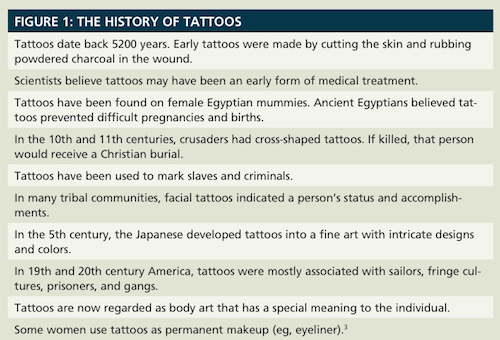Article
Tattoos-Think Before You Ink
Author(s):
Several health risks associated with tattoos can be avoided or reduced by sharing this guide with patients.
Several health risks associated with tattoos can be avoided or reduced by sharing this guide with patients.
What Is a Tattoo?
Tattooing is a form of body art created by injecting ink into the skin. About 21% of adults have tattoos. They are especially popular among young adults. Approximately 36% of those who are 18 to 25 years of age have tattoos.1 Tattoos are created with a machine that acts like a sewing machine. It pierces 1 or more needles into the skin repeatedly. People generally experience mild to moderate pain.2 Tattoo inks vary in color, with red, green, and yellow being the most popular (Figure 1).

What Are the Risks in Getting Tattoos?
The tattoo site can become infected. This happens when bacteria contaminate the ink. Red rashes, swelling, and pain are symptoms of an infection. An infection generally occurs 2 or 3 weeks after you get your tattoo. Antibiotics kill most infections, but some tattoo infections don’t respond to antibiotics. If the tattoo artist is using needles that have been used on other people, these needles can infect others with diseases such as HIV and hepatitis. Even with sterile needles, a tattoo site can become infected.
Some people are allergic to the ink but don’t know it until they get a tattoo. An allergic reaction can occur immediately. In some cases, the reaction occurs several months or years later. Skin bumps, rashes, and itching are signs of an allergic reaction. Medication is necessary if the reaction is severe. Tattoos can also worsen some skin conditions.
Tattoos may result in scar tissue. Small knots or bumps may form around the tattoo. These bumps occur because the body is attempting to remove a foreign substance (ink). It’s possible that the ink may travel into your body. It is unknown if this will cause future problems.4
Should you get a tattoo, follow the guidelines in the sidebar. After getting a tattoo, remove the bandage after 24 hours. Keep the area clean. Apply a moisturizer several times a day for the first few days. Avoid direct sunlight on a new tattoo. Tattoos eventually fade. Sunlight is the main cause of fading. Some inks, like yellow, fade faster than dark inks. If you lose or gain weight, the tattoo may look distorted.4

Up to 50% of people with tattoos wish they’d never gotten tattooed.5 In most cases, these are people in their 40s who got tattooed as young adults. Removing a tattoo is a slow and expensive process. Most insurance plans don’t cover tattoo removal. Tattoo removal should only be done by a dermatologist (a skin doctor). Most tattoos are removed with a laser machine. The machine sends concentrated light bursts into the tattoo. These bursts feel like tiny drops of hot grease falling on the skin. Laser breaks up the ink that the body then removes. Different lasers may be used for different colors. Green, red, and yellow are the most difficult inks to remove. Newer tattoos are also more difficult to remove compared with older tattoos. Most tattoos require 6 to 10 laser sessions.6 The result may not be perfect, and some scarring may occur.
Dermabrasion is another method for tattoo removal. It’s like “sanding” the layer of skin that has the ink. Tattoos can also be removed by cutting away the skin that has the tattoo. The remaining skin is then stitched together.
Can an X-Ray Affect My Tattoo?
A regular x-ray will not damage your tattoo. A type of imaging called magnetic resonance imaging (MRI) heats up some of the components of tattoo ink. This may result in a skin burn. Burning can be prevented. A cold, wet cloth may be placed over the tattoo before the MRI is performed. It is possible for the tattoo to affect the MRI image.7
Final Thought
Think carefully before getting a tattoo. Never get a tattoo if you are drinking or doing drugs. What seemed like a good idea the night before may be regretted in the morning.
Dr. Zanni is a psychologist and health systems consultant based in Alexandria, Virginia.
References
1. American Academy of Dermatology. Dermatologist warns consumers about complications linked to newer tattoo inks. www.aad.org/stories-and-news/news-releases/dermatologist-warns-consumers-about-complications-linked-to-newer-tattoo-inks-.Accessed March 26, 2013.
2. Mayo Clinic Staff. Tattoos: understand the risks and precautions. www.mayoclinic.com/health/tattoos-and-piercings/MC00020. Accessed March 26, 2013.
3. Frankin-Barbajosa. Tattoo: pigments and imagination. Natl Geogr Mag. http://ngm.nationalgeographic.com/ngm/0412/online_extra.html. Accessed April 19, 2013.
4. US Food and Drug Administration. Think before you ink: are tattoos safe? www.fda.gov/forconsumers/consumerupdates/ucm048919.htm. Accessed March 26, 2013.
5. Urdang M, Mallek JT, Mallon WK. Tattoos and piercings: a review for the emergency physician. West J Emerg Med. 2011;12:393-398.
6. Dallas ME. Want to get rid of that tattoo? you’re not alone. http://consumer.healthday.com/health-technology-information-18/lasers-and-laser-surgery-news-439/want-to-get-rid-of-that-old-tattoo-you-re-not-alone-673069.html. Accessed July 29, 2013.
7. Ross JR, Matava MJ. Tattoo-induced skin “burn” during magnetic resonance imaging in a professional football player: a case report. Sports Health. 2011;3:431-434.





